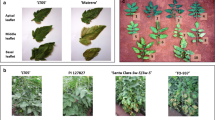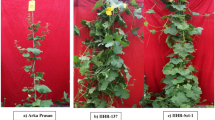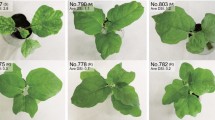Abstract
A total of 90 genotypes of Lycopersicon species were tested forresistance to the Tomato leaf curlgeminivirus (ToLCV) by agroinoculation andthe vector whitefly (Bemisia tabaciGenn.) inoculation techniques underinsect-proof glasshouse conditions. Therate of infection in the inoculated plantswas determined by detection of the viralDNA in individual plants by the nucleicacid spot hybridization (NASH). Of the 38cultivars and 11 breeding lines of L.esculentum Mill. tested, none was highlyresistant or resistant while three andseven were moderately resistant whenexposed to the cloned virus DNAs byagroinoculation and whitefly inoculationrespectively. On the other hand, among the38 commercial cultivars screened, 16(42.1%) were highly susceptible in vectorinoculations and 31 (81.6%) inagroinoculation. Among the exoticcollection (EC) accessions six were highlyresistant, eleven resistant to whiteflyinoculation and none was highly susceptiblein either of the two tests, indicating thepresence of resistance among the ECaccessions. A higher degree of resistancewas observed in other species of Lycopersicon. While only one accession ofL. cheesmanii Riley was tested, itcould not be infected by either of the twomethods. L. pimpinellifolium (Jusl.)Mill. genotype EC 251580 was similarlyresistant. In L. peruvianum (L.)Mill., five EC accessions could not beinfected by whitefly inoculation, withthree of these being resistant and twomoderately resistant in agroinoculation.This study demonstrates the importance ofthe agroinoculation technique in the virusresistance screening programs andidentifies several good sources ofresistance to the Tomato leaf curlvirus in Lycopersicon species.
Similar content being viewed by others
References
Anonymous, 1987. Resistance screening, mechanical transmission and purification of Taiwan tomato leaf curl virus. AVRDC Report, pp. 119-121.
Banerjee, M.K. & G. Kalloo, 1987. Sources of inheritance of resistance to leaf curl virus in Lycopersicon. Theor Appl Genet 73: 707-710.
Banerjee, M.K. & G. Kalloo, 1990. Nature of resistance to tomato leaf curl virus (TLCV) in two species of Lycopersicon. Haryana Agric Univ J Res 20: 225-228.
Channarayappa, G.S., V. Muniyappa & R.H. Frist, 1992. Resistance of Lycopersicon species to Bemisia tabaci, a tomato leaf curl virus vector. Can J Bot 70: 2184-2192.
Czosnek, H., A. Khyer-Pour, B. Gronenborn, E. Remetz, M. Zeidan, A. Altman, H.D. Robinowitch, S. Vidavsky, N. Kedar, Y. Gafni & D. Zamir, 1993. Replication of tomato yellow leaf curl virus (TYLCV) DNA in agroinoculated leaf tissue from selected tomato genotypes. Plant Molec Biol 22: 995-1005.
Dasgupta, I., R. Hull, S. Eastop, C. Poggi-Pollini, M. Blake-Brouth, M.L. Noulton & J.W. Davies, 1991. Rice tungru bacilliform form virus DNA independently infects rice after agrobacterium mediated transfer. J Gen Virol 72: 215-215.
Davies, J.W. & J. Stanley, 1989. Geminivirus genes and vectors. Trends Genet 5: 77-81.
Ditta, G., S. Stanfield, D. Corbin & D.R. Helinski, 1980. Broad host range DNA cloning system for gram negative bacteria. Construction of gene bank of Rhizobium meliloti. Proc Natl Acad Sci USA 77: 7347-7351.
Elmer, J.S., G. Sunter, W.E. Gardiner, L. Brand, C.K. browining, D.M. Bidavo & S.G. Rogers, 1988. Agrobacterium mediated inoculation of plants with tomato golden mosaic DNAs. Plant Molec Biol 10: 225-234.
Feinberg, A.P. & B. Vogelstein, 1984. A technique for radiolabelling DNA restriction endonuclese fragments to high specific activity. Annl Biochem 137: 266-267.
Grimsley, N.H., B. Hohn, T. Hohn & R. Walden, 1986. Agroinfection-an alternative route for viral infection of plants by using the T-plasmid. Proc Natl Acad Sci USA 83: 3282-3286.
Grimsley, N.H., T. Hohn, J.W. Davies & B. Hohn, 1987. Agrobacterium mediated delivery of infectious maize streak virus into maize plants. Nature 325: 177-179.
Hameed, S., 1996. Leaf curl virus of tomatoes and chilis in Pakistan. In: Proceeding of the Phase I Final Workshop of the South Asian Vegetable Research Networks. January 23-28,1996, pp. 242-259. Kathmandu, Nepal.
Hamilton, W.D.O., D.M. Bisaro, R.H.A. Couts & K.W. Buck, 1983. Demonstration of the bipartite nature of the genome of single stranded DNA virus by infection with the cloned DNA components. Nucl Acids Res 11: 7387-7396.
Hanley-Bowdoin, L., S.B. Sottloge, B.M. Orozco, S. Nagar & D. Robertson, 1999. Geminiviruses: Model of plant DNA replication, transcription and cell cycle regulation. Crit Rev Plant Sci 18: 71-106.
Harrison, B.D. & D.J. Robinson, 1999. Natural genomic and antigenic variation in whitefly-transmitted geminiviruses (Begomoviruses). Annu Rev Phytopathol 37: 369-398.
Hondt, M.D. & M. Russo, 1985. Tomato yellow leaf curl in Senegal. J Phytopathology 112: 153-160.
Kalloo, G. & M.K. Banerjee, 1990. Transfer of tomato leaf curl resistance from Lycopersicon hirsutum f. Glabratum to L. esculemtum. Plant Breeding 105: 156-159.
Kalloo, G., 1996. Leaf curl virus of tomato and chili in India. In: Proceeding of the Phase I Final Workshop of the South Asian Vegetable Research Networks. January 23-28, 1996, pp. 242-259. Kathmandu, Nepal.
Kasrawi, M.A., M.A. Suwan & A. Mansour, 1988. Sources of resistance to tomato yellow leaf curl virus in Lycopersicon species. Euphytica 37: 61-67.
Khyer-Pour, A.M., V.M. Bendahmane, G.P. Accotto, S. Crespi & B. Gronenborn, 1991. Tomato yellow leaf curl virus from Sardinia is a whitefly transmitted monopartite geminivirus. Nucl Acids Res 19: 6763-6769.
Kheyr-Pour, A., B. Gronenborn & H. Czosnek, 1994. Agroinoculation of tomato yellow leaf curl virus (TYLCV) overcome the virus resistance of wild Lycopersicon species. Plant Breeding 112: 228-233.
Lazarowitz, S., 1992. geminiviruses: Genome structure and gene function. Crit Rev Plant Sci 11: 327-349.
Mandal, B., A. Varma & V.G. Malathi, 1997. Systemic infection of vigna mungo using the cloned DNAs of blackgram isolate of mungbean yellow mosaic geminivirus through agroinoculation and transmission of progeny virus by whiteflies. J Phytopathology 145: 505-510.
Mandal, B., A. Varma & V.G. Malathi, 1998. Some biological and genomic properties of pigeonpea isolate of mungbean yellow mosaic geminivirus. Indian Phytopath 51: 121-129.
Maule, A.J., R. Hull & J. Donson, 1983. The application of spot hybridization to the detection of DNA and RNA viruses in plant tissues. J Gen Virol 6: 615-624.
Mayo, M.A. & G.P. Martelli, 1993. New families and genera of plant viruses. Arch Virol 133: 496-498.
Mazyad, H.M., A.A. Hassan, M.K. Nakhla & Moustafa, 1982. Evaluation of some wild Lycopersicon species as sources of resistance to Tomato yellow leaf curl virus. Egypt J Hort 9: 241-146.
Morinaga, T., M. Ikagami, T. Arai, K. Yazaki & K. Mirura, 1988. Infectivity of cloned dandem dimmer of DNAs of bean golden mosaic virus. J Gen Virol 69: 897-902.
Muniyappa, V., S.H. Jalikop, A.K. Saikia, Chennarayappa, G. Shivashankar, A.I. Bhat & H.K. Ramappa, 1991. Reaction of Lycoperscon cultivars and wild accessions to tomato leaf curl virus. Euphytica 56: 37-41.
Navot, N., E. Pichersky, M. Zeidan, D. Zamir & H. Czosnek, 1991. Tomato yellow leaf curl virus: a whitefly transmitted geminivirus with single genomic component. Virology 185: 151-161.
Pico, B., M.J. Diez & F. Nuez, 1996. Viral diseases causing the greatest economic losses to the tomato crop. II. The tomato yellow leaf curl virus-a review. Scientia Hortic 67: 151-196.
Pico, B., M.J. Diez & F. Nuez, 1999. Improved diagnostic techniques for tomato yellow leaf curl virus in tomato breeding programs. Plant Disease 83: 1006-1012.
Pilowsky, M. & S. Cohen, 1990. Tolerance to tomato yellow leaf curl virus derived from Lycopersicon peruvianum. Plant Disease 74: 248-250.
Rochester, D.E., W. Kositratana & R.N. Beachy, 1990. Systemic movement and symptom production of following agroinoculation with a single DNA of tomato yellow leaf curl geminivirus (Thailand). Virology 178: 520-526.
Sambrook, J., E.F. Fritsch & T. Maniatis, 1989. Molecular Cloning-A Laboratory Manual. Cold Spring Harbour Laboratory, New York, USA.
Singh, S.J., 1996. Leaf curl virus of tomato and pepper in India. In: Proceeding of the Phase I FinalWorkshop of the South Asian Vegetable Research Networks. January 23-28,1996, pp. 242-259. Kathmandu, Nepal.
Stanley, J., 1985. The molecular biology of geminiviruses. Adv Virus Res 30: 139-177.
Stanley, J. & R. Townsend, 1985. Characterization of DNA forms associated with cassava latent virus infection. Nucl Acids Res 13: 2189-2206.
Stenger, D.C., M.C. Stevenson, S.G. Harmuzdi & D.M. Bisaro, 1992. A number of subgenomic DNAs are produced following agroinoculation of plants with beet curly top virus. J Gen Virol 73: 237-242.
Tripathi, S., 2000. Characterization and Management of Tomato Leaf Curl Geminivirus. Ph.D. Thesis, Indian Agricultural Research Institute, New Delhi, India. p. 87.
Tripathi, S., V.G. Malathi & A. Varma, 1997. A tomato leaf curl geminivirus from Delhi-a distinct isolate. In: p. 151 (Abstract). International Conference on Integrated Disease Management for Sustainable Agriculture. 10-15 Nov. 1997. New Delhi, India.
Varma, Anupam, 1993. Integrated management of plant viral disease. In: Crop Protection and Sustainable Agriculture. Wiely Chichester Ciba Foundation Symposium 177: 140-157.
Varma, J.P., J. Hayati & Poonam, 1980. Resistance in Lycopersicon species to tomato leaf curl disease in India. Zeitschr Pflanzenk Planzensch 87: 137-144.
Zakay, Y., N. Navot, M. Zeidan, N. Kedar, H.D. Robinowitch, H. Czosnek & D. Zamir, 1991. Screening Lycopersicon accession for resistance to tomato yellow leaf curl virus: presesnce of viral DNA and symptom development. Plant Disease 75: 279-281.
Zoysa, I.J., 1996. Leaf curl virus of tomato in Sri Lanka. In: Proceeding of the Phase I FinalWorkshop of the South Asian Vegetable Research Networks. January 23-28, 1996, pp. 265-269. Kathmandu, Nepal.
Author information
Authors and Affiliations
Rights and permissions
About this article
Cite this article
Tripathi, S., Varma, A. Identification of sources of resistance in Lycopersicon species to Tomato leaf curl geminivirus (ToLCV) by agroinoculation. Euphytica 129, 43–52 (2003). https://doi.org/10.1023/A:1021582417062
Issue Date:
DOI: https://doi.org/10.1023/A:1021582417062




